Isle of May lighthouse
| Gaelic name | Eilean Mhàigh |
|---|---|
| Norse name | Máeyar (cf. plural) |
| Meaning of name | Uncertain |
| Location | |
|
Isle of May shown within Fife
|
|
| OS grid reference | NT656992 |
| Coordinates | 56°11′N 2°33′W / 56.18°N 2.55°W |
| Physical geography | |
| Island group | Islands of the Forth |
| Area | 45 hectares (110 acres) |
| Area rank | 210= |
| Highest elevation | 50 metres (160 ft) |
| Administration | |
| Sovereign state | United Kingdom |
| Country | Scotland |
| Council area | Fife |
| Demographics | |
| Population | 0 |
| References | |

Robert Stevenson's lighthouse on the Isle of May.
|
|
|
Scotland
|
|
| Location | Isle of May Fife Scotland United Kingdom |
|---|---|
| Coordinates | 56°11′08″N 2°33′27″W / 56.185630°N 2.557468°W |
| Year first constructed | 1635 (first) |
| Year first lit | 1816 (current) |
| Automated | 1989 |
| Construction | stone tower |
| Tower shape | square parallelepiped tower with balcony and lantern rising from a 2-storey keeper’s house |
| Markings / pattern | unpainted tower, black lantern |
| Height | 24 metres (79 ft) |
| Focal height | 73 metres (240 ft) |
| Range | 22 nautical miles (41 km; 25 mi) |
| Characteristic | Fl (2) W 15s. |
| Admiralty number | A3090 |
| NGA number | 2600 |
| ARLHS number | SCO-286 |
| Managing agent | Northern Lighthouse Board |
The Isle of May is located in the north of the outer Firth of Forth, approximately 8 km (5.0 mi) off the coast of mainland Scotland. It is 1.8 kilometres (1.1 miles) long and less than half a kilometre wide. The island is owned and managed by Scottish Natural Heritage as a National Nature Reserve.
Most visitors to the island are daytrippers taking the ferry from Anstruther in Fife, although up to six visitors can stay at the bird observatory, usually for a week at a time. The only way to get there is by ferry; the journey takes 45 minutes from the small ports of Anstruther and Crail, and also from North Berwick.
The island is closed to visitors from 1 October until Easter to prevent disturbance to the large number of seal pups. The Scottish Seabird Centre at North Berwick has two live cameras on the island, which can be remotely controlled by visitors, to allow close viewing of the seabird cities, including puffins, guillemots, razorbills, shags, cormorants and terns and the fluffy grey seal pups in winter, without disturbance. The Scottish Seabird Centre also runs boat trips to the Isle of May.
There are now no permanent residents, but the island was the site of a St. Adrian's Priory during the Middle Ages.
The Isle of May was designated a National Nature Reserve on 12th June 1956 and is managed by Scottish Natural Heritage (SNH). Although only around 57 hectares in size, over 285 bird species have been recorded on the island. At the height of the breeding season, the Isle of May can host around 200,000 seabirds, including Puffins, Kittiwake, Guillemots, Razorbills, Shags and Fulmars. However, according to Scottish Natural Heritage, these numbers can fluctuate considerably from year to year, depending on weather and fish stocks.
...
Wikipedia


